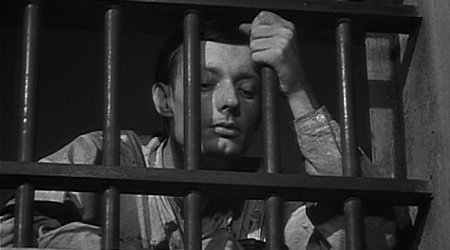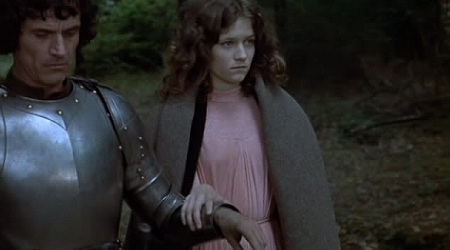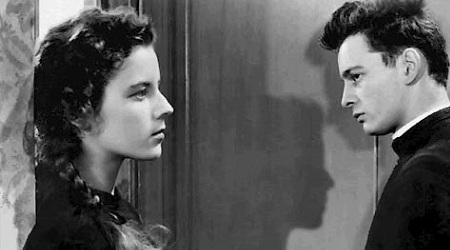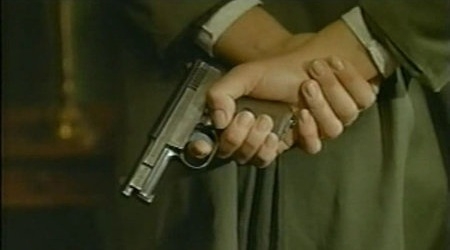Ever since both the release of James Quandt’s much-celebrated anthology, Robert Bresson (the first significant compilation of writing on Bresson in English) and the touring retrospective of Robert Bresson’s work back in 1998, the director’s stock has been skyrocketing stateside. It’s almost mind-blowing to think that, until this century, Au hasard, Balthazar, perhaps the greatest film ever made (in my opinion, of course) wasn’t available in any format, and even still, The Trial of Joan of Arc, A Gentle Woman, and The Devil, Probably, among others, are only available on VHS (which, in this day and age, you might as well say they’re only on Betamax). Yet, despite the continued unavailability of several of his mere 13 films, Bresson is consistently placed in the upper echelon of cinema’s pantheon with the likes of Dreyer, Ozu, Welles, and Kubrick.
While Bresson’s asceticism and focus on internal spiritual struggles often draw comparisons to Dreyer, or in Paul Schrader’s case, Dreyer and Ozu, his style is singular. From his first feature Les Anges du Peche (Angels of Sin) through 1956’s A Man Escaped, one can see the crystallization of his style, a removal of all excess and an intensified focus on the essential, both visually and thematically. Once he reaches this “perfection” in style, his subsequent films continue to offer something new, both in terms of a further refinement and an ever-evolving, complicatedly moral and thematic focus. His perspective begins with that of a true Jansenist, a branch of Catholicism that believes in predestination, and shifts, ever so slightly, with each film toward agnosticism or, at the very least, a belief in an increasing, unbridgeable gap between man and God. But despite the religious undertones of his work, his films are rarely overtly religious and can be thoroughly appreciated in purely secular and cinematic terms. His spirituality is deeply intertwined with his style, so films about a prison break, a pickpocket, a donkey and its various owners, a poor girl struggling after the death of her mother, and even the myth of Lancelot and King Arthur all manage to take on his thematic preoccupations despite superficially sounding nothing alike.
Bresson’s heavy reliance on elliptical editing, fragmented framing, and use of non-actors (he called them “models” and used them more as inexpressive vessels than for dramatic purposes) can appear awkward and confusing to newcomers, but once one tackles his films on their own terms, realizing that what is offscreen or between the cuts is just as vital as what is shown, there is a virtual treasure trove of gifts to be derived from his work. And despite his reputation as an ascetic and minimalist director, his work with color in his last five films is anything but, as the palpable sensuality and suppleness that enter his films adds yet another complicated touch to his already rich tapestry of complex emotions amid personal and spiritual turmoil.
Despite his limited output, Bresson’s oeuvre is most fruitful, challenging, and impressive; this most recent retrospective — at the Aero Theatre in Los Angeles — with brand new 35mm prints of A Man Escaped, The Devil, Probably, and The Diary of a Country Priest, offer North American viewers, for the first time in 14 years and only second time ever, the opportunity to see all but one of his films in 35mm, the way they were meant to be seen. As the last retrospective led to the DVD release of several previously unavailable Bresson films, I can only hope this one will lead to the widespread availability of all the rest, particularly A Gentle Woman and The Devil, Probably, so that no cinephile has a legitimate excuse for leaving any of his films unseen.
Rather than sticking to a more chronological order, the Los Angeles retrospective chose a more interesting and equally effective approach of grouping together thematically similar films that help viewers to hone in on his preoccupations and the varied ways he tackles them at different points in his career. I was unable to see The Trial of Joan of Arc (1962), Les Anges du Peche (1943), or Les Dames du Bois de Bologne (1945) (all three good in their own way, but none close to top-tier Bresson), but here’s what I did manage to catch.
A Man Escaped (1956)

The first screening was of one of Bresson’s most accessible films, but also one of his greatest. The film that first revealed the fruition of the true Bressonian style, A Man Escaped, takes the simple plot of a prison escape and imbues it with rich spirituality through its intensification of material reality and elliptical editing, suggesting a guiding force outside of the characters’ own sheer willpower. For the first time in Bresson’s career, sound plays a vital role — both off-screen, with outer sounds heard from within the cell — and on-screen through the protagonist’s dismantling of portions of his own cell as they are transformed into instruments of his predestined freedom. The fragmented close-ups he was so fond of also make numerous appearances. A Man Escaped transforms the clichéd prison-escape film into a transcendental exercise, an engagement with the material world to reach the spiritual, an arduous journey with a catharsis that can be read simply as redemption or an attainment of grace, or, in line with more recent scholarly and critical takes, a metaphorical coming-out.
Pickpocket (1959) / L’Argent (1983)

On the surface, this appears to be an odd double-feature, pairing his most revered early film with his final film, but the two work remarkably as companion pieces (both were also based on Dostoyevsky short stories), with the latter contrasting the former in many fascinating ways. Pickpocket, loosely based on Crime and Punishment, mostly in its protagonist’s self-proclaimed status as übermensch, is quite simple in terms of plot — a man struggling to get by hones his skills as a pickpocket, ultimately working with small groups of men to pull of more elaborate schemes, and as he is further drawn into this world, his best friend and mother’s nurse struggle to understand him and keep him out of trouble. In other words, on paper, it’s as generic a plot as the prison-break of A Man Escaped, but Bresson transforms the mundane into something completely invigorating and ambiguous, filming the pickpockets in fragments, a disassociation of body and spirit, the act itself a psychosexual ritual and invasion that occasionally comes off as complicit. The film’s homoeroticism has been well-noted, both in terms of Michel’s friendship with the nameless expert and his multiple clandestine attempts at invading men’s personal space while directly confronting them, as has its bizarre path to spiritual redemption and rejuvenation, but it is in the film’s form and powerful materialist/spiritual dichotomy that the true Bressonian struggle is unearthed.
L’Argent, on the other hand, is a strikingly modern film, portraying modern man as greedy, self-serving, pessimistic, and, ultimately, beyond hope. The plot, which is perhaps Bresson’s most elaborate, traces the passing of a counterfeit bill whose use eventually leads to the arrest of Yvon for attempted fraud. Whereas, like Michel in the prior film, Yvon’s imprisonment leaves open the possibility for redemption, the modern simply won’t allow it and the guiding force toward predestined grace in Bresson’s earlier films is no longer to be found. The film’s expressive use of color paints modernity in almost garish, violent hues, symbolically representing the dominance of the superficial when the inevitable and unending transference of money — shown itself as a dead symbol that has now fully suppressed the spiritual realm — contaminates everyone it touches. This transference is mirrored in L’Argent’s circular structure, which allows Bresson to focus on multiple characters in different classes, leading to one of the most damning portraits of capitalist culture on film, with the shocking final act functioning both as a reminder of just how much his philosophy and world view have developed and the perfect final bow for a remarkable career.
Au hasard, Balthazar (1966) / Mouchette (1967)

Perhaps Bresson’s two greatest films, Au hasard, Balthazar and Mouchette, are considered companion pieces of sorts, their protagonists (Balthazar the donkey in the former, poverty stricken preteen Mouchette in the latter) each functioning as fixed points through which the vices and evil of the world pass, symbols of innocence that are slowly destroyed by the modern world. Balthazar, in particular, marks a drastic shift in Bresson’s cinema, both in its increasing skepticism and its broader scope, which focuses more on outside forces at work upon the individual rather than the individual’s path toward grace. As Jean-Luc Godard said of Balthazar, it “comprises of concentric circles overlapping one another,” whereas his previous films were “straight lines.” Structurally and emotionally complex, the film focuses on both Marie, a troubled young girl, and Balthazar, the donkey she gets as a child. After circumstances force the family to sell Balthazar, the film splits, tracking Balthazar through several cruel owners, and Marie, as she attempts to find love and happiness from the unrelentingly vicious Gerard. In a film of stark contrasts, the sheer innocence of Marie (and beauty of Anne Wiazemsky, who plays her) is repeatedly trounced by the destructive actions of Gerard, who even goes to the lengths of senselessly beating Balthazar in front of the hiding Marie, who has just adorned the donkey with a crown of flowers. As Balthazar and Marie encounter the world’s debasement and overwhelming amorality within their small village, the two re-encounter one another repeatedly, with the donkey functioning as a symbol of grace, beauty, and purity — three virtues that become non-existent and increasingly unachievable for Marie as the greed, egotism, and antipathy around her threaten to destroy all that was once good within her.
Mouchette is similar to Au hazard, Balthazar in its thematic preoccupations and rural setting, but as Mouchette is a few years younger than Marie, and is burdened by the added responsibility she must take on because of her dying mother and alcoholic father, the circumstances leave the young girl even less hope of escape. Bresson begins the film with a carefully edited sequence of a hunter setting traps and catching rabbits, symbolically mirroring the various traps Mouchette herself will encounter as she’s brutalized by her father, chided by the townspeople for an inappropriate relationship with the hunter, and seemingly cut off at every turn in all her attempts at happiness and self-realization. One of the truly devastating films of teen poverty and disillusionment, Mouchette sidesteps character psychology, something Bresson himself detests, in favor of examining the social and spiritual forces at work upon Mouchette, resulting in one of the director’s most emotionally charged and immensely rewarding films.
Lancelot du Lac (1974)

As this was the last film screened, I’m taking the liberty of tacking this in front of The Devil, Probably, since I find that Lancelot du Lac marks another drastic shift in Bresson’s cinema, less stylistically than spiritually. Whereas Bresson’s earlier films often focused on a path toward grace and redemption or a sense of transcendence from the material world, his final three films, starting with this demystification of the Arthurian legend, present an unbridgeable rift between man and the spiritual realm. Starting after the failed quest to attain the Holy Grail, Lancelot of the Lake focuses on Lancelot and Guinevere’s affair and the disillusionment of the knights amid the spiritual turmoil and moral bankruptcy that followed the quest. Perhaps Bresson’s most rhythmic film, Lancelot uses a layered, complex sound design that combines the clank of armor, whinny of horses, and distant sounds of birds and horns, creating a natural yet dissonant soundtrack that mirrors the sense of displacement the knights feel and their seemingly unquenchable greed, misplaced honor, and distorted spirituality. Bresson pushes these sonic and visual rhythms past the point of abstraction, leaving the viewer with a fragmented sense of geography, tied together only by the repetition of sounds and color-coded knights. The fragmentation extends to the characterizations and plot as Arthur’s men break into several factions, each as directionless and destructive as the next. With Lancelot of the Lake, the hopelessness becomes total, redemption but a dream.
The Devil, Probably (1977)

Bresson may not seem like the kind of director suited for tackling post-’68 Paris, but The Devil, Probably shows a genuine concern for and understanding of the hopelessness embedded in 1970s counterculture. Following Charles as he tries to find his place in a world full of greed and corruption, the film presents his alternative options (drugs, sex, violence, political extremism, psychology) as equally hollow and unsatisfying as the restrictive social institutions he rebels against. His two lovers and other friends try to help Charles, but his disgust with the world, which often seems to mirror Bresson’s, is unshakeable, his feeling that nothing is any longer genuine, honest, unselfish, or beautiful is made palpable by his odyssey through the Parisian underworld. In a sense, Charles is similar to Bresson’s earlier innocents, saintly in his own way, but the moral and spiritual corruption surrounding him leaves him effectively cut off from grace or redemption. Even Bresson’s earlier suicides had a feeling of positive escape or, once again, transcendence, but Charles can’t even bring himself to commit the act, instead paying a junky friend to murder him. It may be Bresson’s most harrowing film, unflinching in its bleakness, but it’s also a remarkably frank look at teen angst and the spiritual emptiness of the modern world.
Diary of a Country Priest (1951)

It was odd to have such a formative film placed so late in the retrospective, as Diary of a Country Priest was the film that put Bresson on the map, thanks in large part to Andre Bazin’s seminal Cahiers du Cinema article, “The Diary of a Country Priest and the Stylistics of Robert Bresson.” Marking the film in which Bresson worked exclusively with nonprofessional actors, Diary brings stark minimalism, both in terms of his framing, focus on objects, and in the near-expressionless faces of his actors. Despite employing a technique that would distance some viewers for the rest of his career, Bresson’s singular approach to directing allowed for the emotional truth to come solely from the film’s form, particularly his intensification of glances and gesture, acts and movements which contain a remarkable, sub-textual depth. With The Diary of a Country Priest, Bresson approaches spirituality in a much more direct way than his later work, yet the internal struggle of the priest in his inability to successfully cope with — and deter — sin within his parish manages to examine its religious context without ever preaching, instead operating from a more universal level of the individual in relation to the society he or she is supposed to care for.
A Gentle Woman (1969)

Too often dismissed as a minor film in Bresson’s canon, A Gentle Woman is, like Pickpocket, a fascinating Dostoyevsky adaptation marking not only Bresson’s foray into color, but also into modern Paris, wherein he further delves into the soul-crushing materialism he sees as stultifying the spiritual and emotional health of mankind. Using the framing device of a young wife’s suicide, A Gentle Woman is told mostly through flashbacks (oddly enough, the only time in Bresson’s career any flashback was ever used) from the cold, controlling husband’s perspective. The pawn shop, owned by the husband, is a perfect metaphorical device for Bresson’s focus on exchanges and transactions, highlighting the mechanical nature of human interaction and its increasing reliance on material goods and superficial pleasures for self fulfillment. As the nameless wife (played by Dominque Sanda, who was the only Bressonian model to continue on to stardom) transitions from being a graceful recipient of the man’s assistance to becoming frustrated and disgusted by his attempts to constrain her, she begins to experience the deadening void created by a loveless marriage. The pastel cinematography creates a soft, lush image that stresses the purity and innocence of her being as it is slowly crushed by the weight of a callous, indifferent world. In many ways A Gentle Woman is an odd film in the Bresson canon, but for me it remains one of his finest works.
